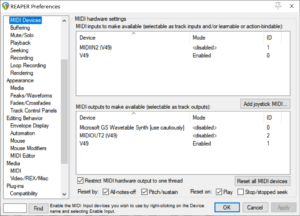I did buy an
Alesis V49 MIDI controller, so the next step was to hook it up. However, the programs I tried (
Reaper,
LMMS) did not seem to work with the controller. I was able to see the controller as an option in the Preferences/Settings pages for these apps, and was able to select them. However, when I followed the EXACT instructions from web pages and videos from these companies, there was no sound when I would press a key on the keyboard, and no indication that the program was detecting the key presses. I downloaded the MIDI utility program
MIDI-OX, which indicated that my Windows 7 laptop was receiving key-on and key-off data, so it seemed like everything was working – but it wasn’t!
I then went to the store (Guitar Center) and talked with the “Pro Tools” employee, who showed me what a working setup should look like (he was using a different controller than mine and a copy of Ableton Live for the Mac). He said it was likely a software problem (what! I AM a software engineer!), and that it took him several months to get the hang of using digital audio workstation (DAW) software.
Frustrated, I decided to download a copy of Ableton Live Lite (since my MIDI controller had a license code for a free copy), and … after a 20 minute download and a 20 minute installation, I was able to use my controller to play some notes in Ableton Live Lite – FINALLY!
Now, what did I want to do with this controller…..?
